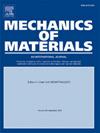High speed investigation of spatio-temporal localization of plastic deformation and fracture of notched Al-Mg specimens exhibiting intermittent plasticity
IF 3.4
3区 材料科学
Q2 MATERIALS SCIENCE, MULTIDISCIPLINARY
引用次数: 0
Abstract
Intermittent plasticity, known as the Portevin-Le Chatelier (PLC) effect and the yield point phenomenon, is a striking example of unstable mechanical behavior of metals and alloys caused by localization of plastic deformation within the PLC and Lüders bands. In present work dynamics and morphology these bands in notched specimens of an AlMg6 (AA5059) commercial alloy under stress-rate controlled tensile tests was investigated. The strain and force responses to the formation and propagation of deformation bands were measured synchronously with high-speed video recording of the specimen surface with a time resolution of 0.2 ms. The results show that the notch is an attractor of deformation bands from the Lüders band to the neck. The notch reduces the effective size of the gauge part of the specimen to a value comparable to the width of the specimen and causes premature sudden failure, reducing the resource of strength and ductility of the alloy. The deformation bands generated by the notch tip cause strain jumps, i.e. steps in the stress-strain curve and stress drops in the complex structure of the force response. It was established that the local rate of plastic deformation in the Lüders band and the PLC band exceeds the average strain rate of the specimen by 3 and 3.5 orders of magnitude, respectively. The spatial statistical distribution of the bands has a sharp maximum in the section along which the main crack will pass. It is a shear crack (type II) that propagates viscously at a velocity of several m/s along the PLC band in the neck structure. Before the rupture the moments of PLC band nucleation self-organize into time sequence that obeys an exponential law. The role of Lüders and subsequent PLC bands in the mechanism of neck formation and failure of a notched specimen is discussed.
断续塑性缺口Al-Mg试样塑性变形与断裂时空定位的高速研究
间歇性塑性,被称为波特文-勒夏特列(PLC)效应和屈服点现象,是由PLC和l ders带内塑性变形局部化引起的金属和合金不稳定力学行为的一个显著例子。本文研究了AlMg6 (AA5059)工业合金缺口试样在应力速率控制拉伸试验中的工作动力学和形貌。采用时间分辨率为0.2 ms的高速录像同步测量了变形带形成和扩展过程中的应变和力响应。结果表明,缺口是由 ders带向颈部变形带的吸引子。缺口使试样规范部分的有效尺寸减小到与试样宽度相当的值,并导致过早的突然破坏,降低了合金的强度和延展性。缺口尖端产生的变形带在力响应的复杂结构中引起应变跳变,即应力-应变曲线的阶跃和应力下降。结果表明,l ders带和PLC带的局部塑性变形速率分别超过试样的平均应变速率3和3.5个数量级。带的空间统计分布在主裂纹通过的截面上有一个明显的最大值。这是一种剪切裂纹(II型),沿着颈部结构的PLC带以几米/秒的速度粘性传播。断裂前PLC带形核矩自组织成服从指数规律的时间序列。本文讨论了l ders和随后的PLC条带在缺口试样颈部形成和破坏机制中的作用。
本文章由计算机程序翻译,如有差异,请以英文原文为准。
求助全文
约1分钟内获得全文
求助全文
来源期刊

Mechanics of Materials
工程技术-材料科学:综合
CiteScore
7.60
自引率
5.10%
发文量
243
审稿时长
46 days
期刊介绍:
Mechanics of Materials is a forum for original scientific research on the flow, fracture, and general constitutive behavior of geophysical, geotechnical and technological materials, with balanced coverage of advanced technological and natural materials, with balanced coverage of theoretical, experimental, and field investigations. Of special concern are macroscopic predictions based on microscopic models, identification of microscopic structures from limited overall macroscopic data, experimental and field results that lead to fundamental understanding of the behavior of materials, and coordinated experimental and analytical investigations that culminate in theories with predictive quality.
 求助内容:
求助内容: 应助结果提醒方式:
应助结果提醒方式:


